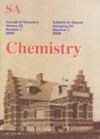Synthesis, characterisation and optimisation of bulk molecularly imprinted polymers from nonsteroidal anti-inflammatory drugs
IF 0.8
4区 化学
Q4 CHEMISTRY, MULTIDISCIPLINARY
South African Journal of Chemistry-Suid-Afrikaanse Tydskrif Vir Chemie
Pub Date : 2022-01-01
DOI:10.17159/0379-4350/2022/v76a09
引用次数: 2
Abstract
The scope of this study was to synthesise and characterise the multi-template molecularly imprinted polymer (MIP) and to use target compounds, naproxen, ibuprofen, diclofenac, fenoprofen and gemfibrozil as templates so as to achieve all maximum extraction efficiency for all compounds. These compounds are a class of nonsteroidal anti-inflammatory drugs (NSAIDs) generally used by humans, as they have pain-relieving activities. MIPs are cross-linked polymeric materials that display high binding capacity and selectivity towards templates of interest. The synthesis consisted of a bulk polymerisation process at 60 °C by using NSAIDs as multi-templates, ethylene glycol dimethacrylate (EGDMA), 2-vinyl pyridine (2VP) and toluene as cross-linker, functional monomer and porogen, respectively. Nonimprinted polymer (NIP) was synthesised in a similar manner with the omission of the templates. Characteristics of the polymers were analysed using Scanning Electron Microscopy (SEM), Fourier Transformed Infrared Spectroscopy (FTIR), Solid State Nuclear Magnetic Resonance Spectroscopy (NMR) and Thermal Gravimetric Analysis (TGA). An adsorption method of NSAIDs using the bulk polymerised MIP was investigated under various pH, mass, concentration and time conditions. Other parameters included adsorption kinetics and adsorption isotherms. Uptake of NSAIDs from an aqueous medium was achieved with 40 mg of MIP at pH 4.0 within 10 min of contact time. The extraction efficiencies achieved for NSAIDs in aqueous solutions ranged from 90–98% for all compounds tested. The adsorption capacity obtained for MIP ranged from 1.230–1.249 mg g−1 and 0.90–1.136 mg g−1 for NIP, whereas the selectivity values ranged from 1.12–2.4. A kinetic study revealed that adsorption obeys a second-order rate, and the Langmuir model explains adsorption isotherm data. This work showed that the multi-template approach for all the target compounds has the potential to give maximum extraction efficiencies in MIP extraction systems from aqueous samples.非甾体抗炎药分子印迹聚合物的合成、表征和优化
本研究的范围是合成和表征多模板分子印迹聚合物(MIP),并以目标化合物萘普生、布洛芬、双氯芬酸、非诺洛芬和吉非罗齐为模板,以达到所有化合物的最大提取效率。这些化合物是一类非甾体类抗炎药(NSAIDs),通常被人类使用,因为它们具有缓解疼痛的活性。mip是一种交联聚合物材料,对感兴趣的模板具有高的结合能力和选择性。以非甾体抗炎药为多模板剂,乙二醇二甲基丙烯酸酯(EGDMA)、2-乙烯基吡啶(2VP)和甲苯为交联剂、功能单体和多孔剂,在60℃下进行本体聚合。非印迹聚合物(NIP)以类似的方式合成,省略模板。采用扫描电子显微镜(SEM)、傅里叶变换红外光谱(FTIR)、固体核磁共振光谱(NMR)和热重分析(TGA)分析了聚合物的特征。在不同的pH、质量、浓度和时间条件下,研究了本体聚合MIP吸附非甾体抗炎药的方法。其他参数包括吸附动力学和吸附等温线。在接触时间10分钟内,在pH 4.0条件下,用40 mg MIP从水介质中摄取非甾体抗炎药。非甾体抗炎药在水溶液中的萃取效率在90-98%之间。MIP的吸附量为1.230 ~ 1.249 mg g−1,NIP的吸附量为0.90 ~ 1.136 mg g−1,选择性为1.12 ~ 2.4。动力学研究表明,吸附服从二阶速率,Langmuir模型解释了吸附等温线数据。这项工作表明,对所有目标化合物的多模板方法有可能在MIP萃取系统中从水样品中获得最大的萃取效率。
本文章由计算机程序翻译,如有差异,请以英文原文为准。
求助全文
约1分钟内获得全文
求助全文
来源期刊
CiteScore
3.10
自引率
0.00%
发文量
6
审稿时长
>12 weeks
期刊介绍:
Original work in all branches of chemistry is published in the South African Journal of Chemistry. Contributions in English may take the form of papers, short communications, or critical reviews.

 求助内容:
求助内容: 应助结果提醒方式:
应助结果提醒方式:


